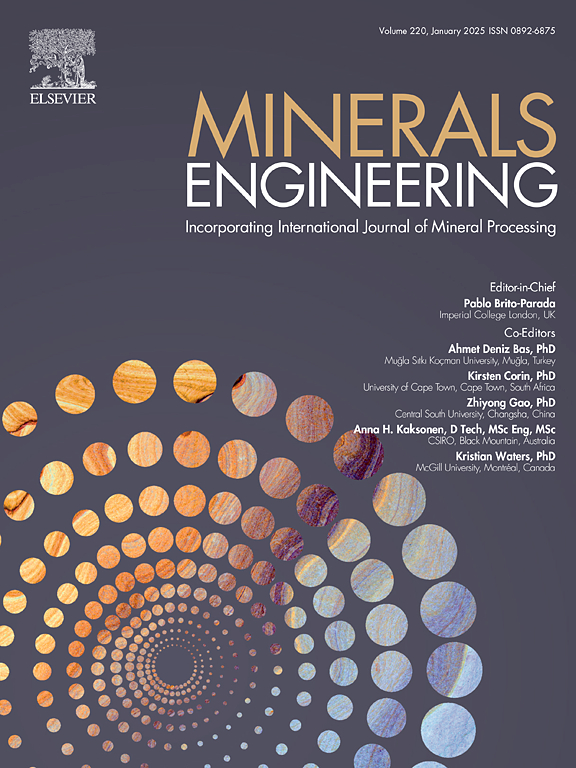Insights into gangue reagent interactions using process mineralogy
IF 4.9
2区 工程技术
Q1 ENGINEERING, CHEMICAL
引用次数: 0
Abstract
Depressants are used to enhance the valuable minerals recovery and flotation selectivity by depressing the gangue minerals and limiting their deportment to the concentrate. This study examines the performance of various CMC depressants with the aim of gaining an understanding of the depressant and gangue minerals characteristics that play a role during froth flotation of PGM ore types.
The case study was conducted on a Platreef ore, where batch flotation tests were performed, and the concentrates were mineralogically characterised. Further test work was conducted on the Great Dyke, Merensky and UG2 ores to confirm the trends observed for Platreef ore. The results revealed a strong correlation between gangue mineral type and depressant characteristics. Consequently, using a mixture of different CMC depressants, each with unique properties, may be more effective than relying on a single CMC. This approach allows for tailored depressant formulations, adding value for concentrators treating PGM ores. It clearly demonstrates that the ore’s mineralogy dictates the appropriate depressant reagent type for PGM ore flotation.
利用工艺矿物学洞察脉石试剂相互作用
抑制剂通过抑制脉石矿物,限制其向精矿中运移,从而提高有价矿物的回收率和浮选选择性。本研究考察了各种CMC抑制剂的性能,目的是了解在PGM矿石类型泡沫浮选过程中起作用的抑制剂和脉石矿物特征。案例研究是在Platreef矿石上进行的,在那里进行了批量浮选试验,并对精矿进行了矿物学表征。进一步对Great Dyke、Merensky和UG2矿石进行了测试,以证实Platreef矿石的趋势,结果表明脉石矿物类型与抑制剂特征之间存在很强的相关性。因此,使用不同CMC抑制剂的混合物,每种都具有独特的性能,可能比依赖单一CMC更有效。这种方法允许定制抑制剂配方,增加了选矿厂处理PGM矿石的价值。结果表明,矿石的矿物学特征决定了PGM矿石浮选的抑制剂类型。
本文章由计算机程序翻译,如有差异,请以英文原文为准。
求助全文
约1分钟内获得全文
求助全文
来源期刊

Minerals Engineering
工程技术-工程:化工
CiteScore
8.70
自引率
18.80%
发文量
519
审稿时长
81 days
期刊介绍:
The purpose of the journal is to provide for the rapid publication of topical papers featuring the latest developments in the allied fields of mineral processing and extractive metallurgy. Its wide ranging coverage of research and practical (operating) topics includes physical separation methods, such as comminution, flotation concentration and dewatering, chemical methods such as bio-, hydro-, and electro-metallurgy, analytical techniques, process control, simulation and instrumentation, and mineralogical aspects of processing. Environmental issues, particularly those pertaining to sustainable development, will also be strongly covered.
 求助内容:
求助内容: 应助结果提醒方式:
应助结果提醒方式:


